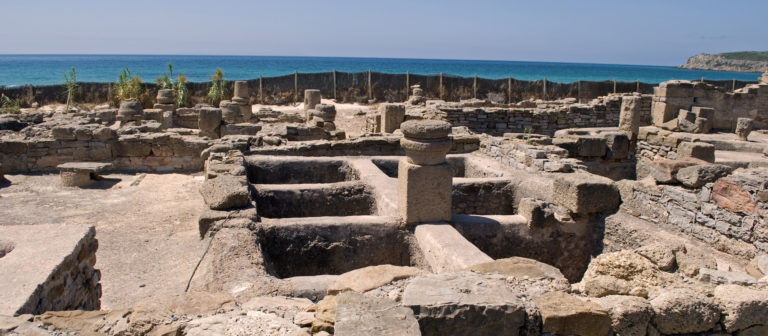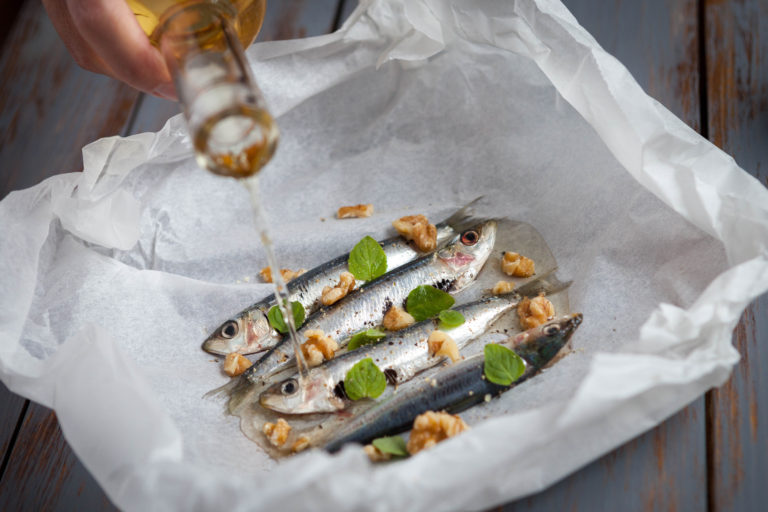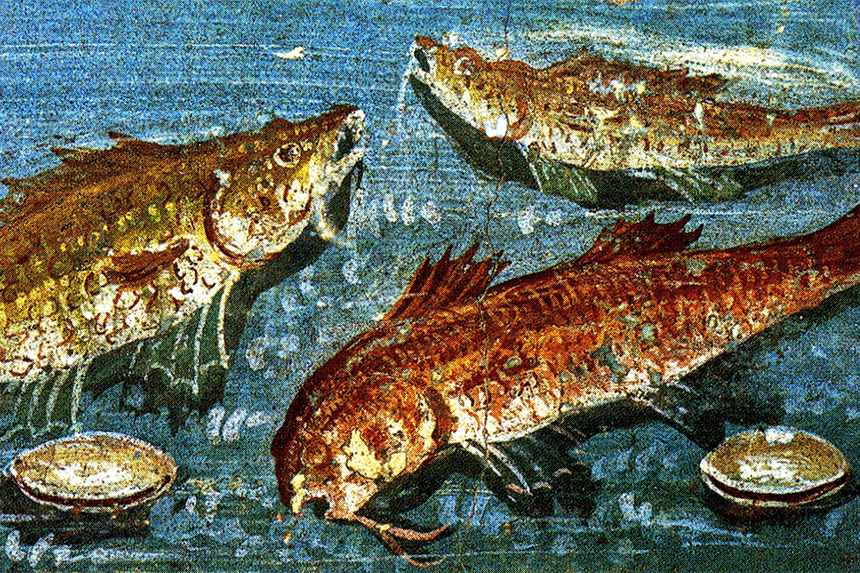If it comes to flavour, Romans really loved the salty smelly fermented fish sauce garum or liquamen. Garum was the most popular seasoning in Roman Antiquity.
A lot has been preserved from the ancient Romans, but unfortunately, flavours and smells have not. Nonetheless, experimenting with the recipes we have from roman manuscripts gives us an idea of what roman food could have possibly tasted like. Roman cuisine can be characterized best by combinations of sweet & sour and sweet & savoury, with some spiciness here and there. And then there is garum. Except for the salty flavour, it adds a very deep, complex, unique, difficult to define taste to a dish and it is not fishy. The best way to describe it is with the Japanese term umami.
The garum production process
Garum is a liquid that is the product of a fermentation process of fish. This fermented fish sauce was made either by taking a whole fish or just the intestines of fish, or sometimes even just their blood. This was put into big jugs or containers with a certain amount of salt, which activated certain enzymes in the fish. This kickstarts the fermentation process, which is just fancy language for saying that the fish started to rot. The fish needed to be stored in the jugs for three to five months where it dissolves into a brown, salty liquid: garum. Garum does not only need time to develop, but it also needs warmth. This explains why ancient texts say that you need to store the full containers on flat roofs for some months, so they are right in the warmth of the sun.
Plinius wrote about garum: “except perfume, there are no liquids in higher regard“.
Despite having a pretty bad smell, garum was produced on a huge scale. Excavations in for instance Pompeii, Barcelona, Morocco, Libya and Andalusia gave us proof that there have been big fish-sauce factories. From Andalusia came a variation of garum made with mackerels called garum sociorum . This fish sauce was considered one of the best and was sold in the whole Roman empire. Amphoras have been found all over Europe carrying labels that indicated they contained this specific fish sauce. Even in the Netherlands, they found a jar with preserved mackerels from Spain. They were found at the Kops Plateau in Nijmegen and are now on display at the Valkhof Museum in the same city.

Different kinds of fish sauces
There are four kinds of fish sauces known from ancient texts: garum, liquamen, muria and allec. The quality and composition of these fish sauces seem to have changed multiple times over the course of time. Garum was known as the best out of the four during the first century, but in the fourth century, the best one was considered liquamen. In the second century B.C., allec was only given to slaves, whereas it was a high standing delicacy in the fourth century, made from the livers of mullet and sea urchins. Considering all these changes, it can take quite some time to figure out which fish sauce was used in a recipe.
Roman fish sauce was made from one kind of fish (for instance mullet, tuna or mackerel) or a mix of different fish. According to Plinius, these sauces were so delicious that you could drink them straight from the bottle. Sometimes they added herbs or spices for a more complex flavour. There is even a recipe for Jewish people: garum castrum, made without shellfish.
Use of garum in ancient times
De re coquinaria, or On the Subject of Cooking, is the only cookbook that is left from Roman times. This so called Apicius cookbook contains 459 recipes, of which 347 call for the use of fish sauce. It is used in sauces, marinades, dressings, stews, casseroles and even desserts.
Garum was also used to make a set of standard sauces. Garum mixed with wine for instance was called oenogarum. When mixed with vinegar, it became oxygarum and when mixed with water, it was called hydrogarum. These sauces are mentioned as ingredients in the recipes from De re conquinaria. Fish sauce was also used as a general seasoning during dinner. This can be compared to the modern-day saltcellar.
Flavour
But…what does garum taste like? In the first place, it is very fishy and quite salty, of course. The Romans did not use regular salt as we do nowadays, they only used it scarcely and mostly to preserve food. Garum does not only add a salty taste to a dish, but it also adds a very special flavour to a dish, without giving it a fishy aftertaste. Foodies would call that special taste umami.
So, let’s not think of the Romans as savages, eating dishes with disgusting rotten fish sauce. Rather let’s think of them like civilised people who invented dishes with deep, complex and unique flavours.
Fish sauce is still traditionally made in Cetara, Italy and is called Colatura di Alici. They make the sauce by layering small anchovies and salt in wooden barrels and letting them ferment for five months. You can see it on this video. It is really an extraordinary addition to your kitchen cabinet. The sauce gives your sauces, marinades, dressings, stews, omelettes, casseroles and fruit salads a taste of history and a delicious flavour.

Even though the ancient Roman kitchen can be a bit strange at first, it has loads of delicious recipes once you have gotten used to the flavours. One of my favourite recipes with garum from De re coquinaria is fish wrapped in papyrus.
Sauce with sardines. The stuffed sardines should be prepared as follows. Remove the bones and grind pennyroyal, cumin, pepper kernels, mint, walnuts, honey. Fill it and stitch up. Roll it in the paper and put it above the fire in a pot with a lid. Season with oil, caroenum and allec.
Fish wrapped in papyrus
Ingredients
4 sheets of baking paper
cooking rope
4 big, fresh sardines, gutted
100 ml white wine
1 tbs olive oil
1 tbs honey
2 tsp garum
1 tsp black or long pepper
1 tsp ground cumin
2 sprigs of mint
2 sprigs of pennyroyal (if you cannot find pennyroyal you can also use 2 sprigs of mint extra)
4 tbs walnuts
Preparation
Put the wine, olive oil, honey, garum, pepper and cumin in a bowl and stir until you have a smooth dressing. Remove the mint and pennyroyal leaves from their stems and chop the leaves finely. Add to the dressing. Chop the walnuts.
Take a sheet of baking paper and put one fish on top. Sprinkle the in- and outside of the fish with the dressing and add some chopped walnuts. Fold the paper around the fish and wrap it like a present. Secure it using the cooking rope. Repeat this for every fish and put them on a baking tray.
Stew the fish for approximately 15 minutes in a preheated oven (180 decrees) until they are done. It depends on the size of the fish how long this takes. Serve them while still in the paper with some finely chopped fresh mint and roasted walnuts next to it. You can add these to the fish after opening the paper, to give them even more flavour and texture.

